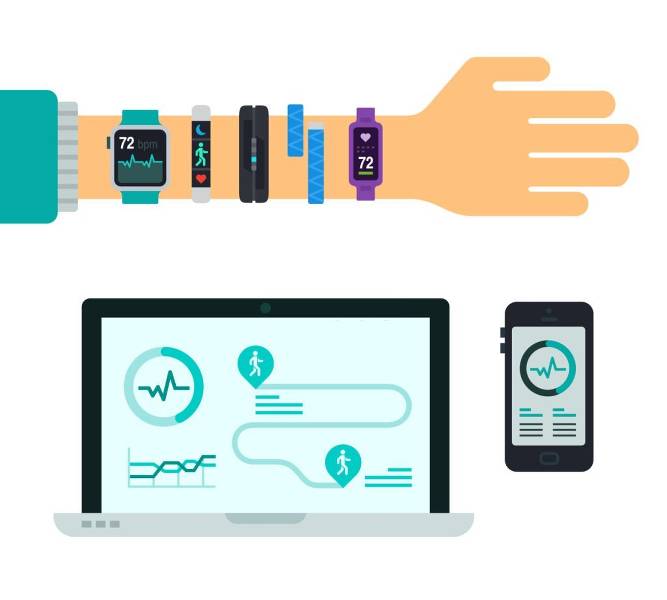
From Grueling to Great: How Fitness Tracking Is Improving Field Service Efficiency

We all know how important it is to stay fit, but did you know that fitness tracking can also improve field service efficiency? By harnessing the power of technology, companies can now monitor their employees’ performance in real time. This article will explore how fitness tracking transforms field service operations and increases operational efficiency.
Field service has traditionally been a labor-intensive industry, with manual processes making tracking employee productivity and performance difficult. However, this is all changing thanks to wearable fitness trackers. These devices provide organizations with detailed insights into employee performance, enabling them to identify areas for improvement and drive better results.
By leveraging the data from fitness trackers, organizations can make more informed decisions that help improve operational efficiency and reduce costs. In this article, we’ll examine how fitness tracking is revolutionizing field service and driving greater business success. So let’s get started!
What Is Fitness Tracking In Field Service
Fitness tracking in field service management refers to the practice of monitoring the physical activity and health metrics of employees who work in the field, such as technicians, delivery drivers, or other mobile workers. This is typically done through wearable devices such as smartwatches or fitness trackers worn by employees while they work.
The data collected by these devices can provide valuable insights into employee health and fitness levels, which can be used to optimize work schedules, improve employee productivity, and reduce the risk of work-related injuries or illnesses. For example, managers can use fitness tracking data to identify workers who may be at risk of burnout or overexertion and adjust their workloads accordingly.
In addition to improving employee health and safety, fitness tracking in field service management can also lead to cost savings for companies. By reducing the likelihood of workplace injuries or illnesses, companies can save money on healthcare costs and workers’ compensation claims.
Field service teams can better understand their technicians’ strengths and weaknesses by using fitness tracking. They can identify areas where extra training may be necessary or where more efficient processes could be implemented. This allows them to make better decisions about managing their team and assigning tasks accordingly. Additionally, having access to real-time data, they can quickly respond to problems during a technician’s workday.
The data collected from fitness tracking also helps managers create reports that provide detailed insights into each technician’s performance over time. This allows them to assess the effectiveness of their strategies for managing the team and adjust them as needed for better results in the future. As a result, managers have greater visibility into how well their technicians are performing, empowering them to make more informed decisions about how best to use their resources for maximum efficiency. With this knowledge, they can empower their field technicians with the skills and tools necessary for success.
Benefits Of Fitness Tracking For Field Service Efficiency

Employing fitness tracking in field service management can have several benefits for both field technicians and field service companies, including:
Advantages for Field Technicians:
- Improved health and wellness: Fitness tracking can help technicians monitor their physical activity levels, heart rate, and other health metrics, which can lead to better overall health and wellness.
- Reduced risk of injury: By monitoring physical activity levels, fitness tracking can help technicians avoid overexertion or burnout, reducing the risk of work-related injuries.
- Better work-life balance: With insights into their physical activity and health, technicians can make more informed decisions about their work schedules and prioritize self-care.
- Increased motivation: The ability to track and monitor progress towards fitness goals can help technicians stay motivated and engaged with their work.
Advantages for Field Service Companies:
- Improved productivity: Healthier, more motivated technicians are likely to be more productive and efficient, leading to better service delivery and customer satisfaction.
- Cost savings: By reducing the likelihood of workplace injuries or illnesses, companies can save money on healthcare costs and workers’ compensation claims.
- Improved scheduling: With insights into technicians’ physical activity levels, companies can better manage workloads and ensure that technicians are not overworked or at risk of burnout.
- Competitive advantage: Companies that prioritize employee health and wellness are likely to attract and retain top talent, improving their competitiveness in the marketplace.
Overall, fitness tracking in field service management can lead to improved health and wellness for technicians, increased productivity and cost savings for companies, and a competitive advantage in the marketplace.
The use of fitness tracking within a field service organization also provides valuable insight into employee performance levels. It can be used to monitor employees’ activities, such as job completion times or travel distances between customers’ sites. It can then be tracked over time to identify areas where improvements are needed. Furthermore, it enables managers to make real-time decisions based on accurate data regarding technician availability or equipment utilization, resulting in improved operational efficiencies.
By utilizing the power of fitness tracking technology within their field service operations, businesses can gain greater visibility into their workforce activity while streamlining their processes to drive better business outcomes. As such, it’s no wonder many organizations have embraced this technology to optimize their workflows and maximize efficiency across their entire organization. As we move forward, this trend will only increase as organizations realize the full potential of fitness tracking for field service efficiency.
Types Of Devices Used For Fitness Tracking

The tools and equipment used for fitness tracking greatly impact field service efficiency. Field service management involves using technology to monitor field operations, and fitness-tracking devices are essential for this. These devices provide accurate data on service delivery, which helps ensure that fix rates are met and the first-time fix is achieved. Real-time information also enables better decision-making in the field.
Several types of fitness tracking devices can be used in field service management, including:
-
Smartwatches: Smartwatches are wearable devices that can track a wide range of health and fitness metrics, including steps taken, distance traveled, heart rate, and calories burned. Many smartwatches also include GPS tracking, which can be useful for field technicians who need to navigate to different job sites.
-
Fitness trackers: Fitness trackers are wearable devices that are designed specifically to track physical activity and health metrics. They typically come in the form of a wristband or clip-on device and can track steps taken, and distance traveled, calories burned, and other metrics.
-
Biometric sensors: Biometric sensors can be used to monitor a wide range of health and wellness metrics, including heart rate, blood pressure, and oxygen saturation. These sensors can be integrated into wearable devices or other types of technology, such as smartphones or tablets.
-
Mobile apps: Mobile apps can be used to track physical activity and health metrics, and can be installed on smartphones or tablets that field technicians already use for work. Many popular fitness tracking apps, such as Fitbit and Strava, can be used in conjunction with wearable devices or standalone.
-
GPS tracking devices: GPS tracking devices can be used to monitor the location and movement of field technicians, which can be useful for optimizing work schedules and ensuring that technicians are working efficiently.
The specific type of fitness tracking device used in field service management will depend on the company’s needs and the technicians’ preferences.
Technology has continued to evolve over the years, making it easier to track activities accurately with minimal fuss or effort. There are now apps that integrate with fitness trackers so that data can be synced quickly and easily across multiple devices. This allows users to keep an eye on their performance from anywhere at any time.
These devices have enabled increased visibility in the field service industry, allowing managers to gain real-time insights into their teams’ performance.
Impact On Field Service Management Productivity
It’s easy to understand why some might hesitate to implement fitness tracking devices for field service technicians. However, the benefits of such technology are undeniable. Fitness tracking devices can provide a more efficient way of managing field service issues and keeping track of the whereabouts of field technicians. By providing field technicians with the ability to better communicate their location and status on-site, fitness tracking devices can significantly improve productivity in the field service industry.
One way fitness tracking improves field service productivity is by making it easier for management systems to track their field technicians’ locations. With this data, managers can quickly identify which areas may need more resources or extra attention. This improved communication between management and technicians allows for faster resolution of service issues and a smoother service experience overall.
Fitness tracking can improve productivity for field service technicians and the overall work in several ways, including:
-
Reducing downtime: By monitoring physical activity levels, fitness tracking can help technicians avoid overexertion or burnout, which can lead to increased downtime due to work-related injuries or illnesses. This means that technicians are more likely to be able to complete their work in a timely and efficient manner.
-
Improving scheduling: With insights into technicians’ physical activity levels, companies can better manage workloads and ensure that technicians are not overworked or at risk of burnout. This means that technicians are more likely to be able to work efficiently and effectively, without becoming fatigued or overwhelmed.
-
Enhancing focus: Regular physical activity has been shown to improve cognitive function and focus. By monitoring physical activity levels, fitness tracking can help technicians stay alert and focused on the job at hand, which can lead to increased productivity and efficiency.
-
Providing motivation: The ability to track and monitor progress towards fitness goals can help technicians stay motivated and engaged with their work. This can lead to increased productivity, as technicians are more likely to be focused on achieving their work goals.
-
Promoting better health: Improved physical health can lead to improved mental health, which can in turn lead to increased productivity. By monitoring physical activity levels, fitness tracking can help technicians prioritize their health and wellness, leading to increased productivity and overall job satisfaction.
Overall, fitness tracking can improve productivity for field service technicians and the overall work by promoting better health, providing motivation, enhancing focus, and reducing downtime. This can lead to improved service delivery, increased customer satisfaction, and a competitive advantage in the marketplace
The use of fitness tracking technology also makes it easier for businesses to provide their field technicians with real-time updates on their progress and any changes in the work environment while they are out in the field. This helps ensure that all tasks are completed efficiently and without delays, enabling companies to deliver better customer service experiences. By leveraging FSM software integrated with fitness tracking capabilities, businesses can gain greater visibility into their operational performance and ensure their teams provide exceptional customer satisfaction no matter where they’re located or what time it is.
Impact On Customer Relationship
The use of fitness tracking in field service operations has positively impacted customer satisfaction. With the ability to track a field technician’s daily activities, customers can receive faster and more accurate service times. This helps improve customer satisfaction and gives customers more confidence in the quality of services they are receiving. It also allows companies to resolve customer issues better, quickly and efficiently.
Companies can leverage data to improve customer relationship management programs by tracking the right Key Performance Indicators (KPIs). This helps them gain valuable insights into their customer base and make informed decisions on how to better meet their needs. Furthermore, it enables them to identify areas for improvement in order to provide better services that lead to increased customer satisfaction.
By accurately tracking a field technician’s daily activities, companies can ensure that their customers receive the highest quality of service possible. This helps create a positive experience for customers as well as build trust between them and the company. As such, fitness tracking has proven to be an effective tool for improving customer satisfaction levels in field service operations.
Automate And Integration To Improve Field Service Team

To automate and integrate fitness tracking for the best field service practices, the following steps can be taken:
-
Select the right fitness tracking technology: Choose a fitness tracking technology that suits the needs of the field service organization and the field technicians. This could be a wearable device, a mobile app, or other type of technology.
-
Integrate fitness tracking with field service management software: Fitness tracking data should be integrated with the field service management software to ensure that it is easily accessible and can be used to optimize scheduling and workloads.
-
Define fitness goals: Define fitness goals for the field technicians that are aligned with the company’s overall goals and objectives. This could include metrics such as steps taken, distance traveled, and calories burned.
-
Establish incentives and rewards: Establish incentives and rewards to encourage field technicians to use fitness tracking technology and achieve their fitness goals. This could include bonuses, extra time off, or other incentives.
-
Monitor and analyze data: Regularly monitor and analyze fitness tracking data to identify trends, areas for improvement, and opportunities to optimize scheduling and workloads.
-
Provide training and support: Provide training and support to ensure that field technicians understand how to use fitness tracking technology effectively and are motivated to achieve their fitness goals.
By automating and integrating fitness tracking with field service management practices, organizations can improve productivity, reduce downtime, and enhance the health and well-being of their field technicians. This can lead to improved service delivery, increased customer satisfaction, and a competitive advantage in the marketplace.
In addition to helping improve operational efficiency, integrating fitness tracking into field service also has the potential to open up new opportunities for customers. For example, customers may be able to request services more quickly or be able to receive personalized recommendations based on their activity levels or goals. By leveraging this technology, businesses can offer better experiences for their customers while also increasing their own efficiency.
These advancements in automation and integration demonstrate how fitness tracking is transforming the way field services operate, leading to improved efficiency and better customer satisfaction levels. However, with challenges in deployment and implementation remaining, there is still room for improvement in this area.
Challenges In Deployment And Implementation
Deploying and implementing fitness tracking for field service efficiency can be a challenge. Fitness tracking requires access to customers’ location data, which can sometimes be difficult to obtain. Additionally, the fitness tracking cost may not fit the customer’s budget. This can often lead to poor adoption rates and an inability to see any return on investment or bottom-line improvement.
Another challenge that often arises is difficulty creating systems integrating fitness tracking into existing workflow processes. Fitness tracking requires integration with other software systems and databases, which is not always easy to accomplish depending on the age and complexity of the system already in place. If done incorrectly, there is potential for data collection and reporting errors or even a complete breakdown of the system.
Finally, additional challenges arise when it comes to integrating multiple members of the team into a single system. Suppose field service teams are too large or spread out across multiple locations. In that case, it can become very difficult to track individual performance and make use of all of the data collected from fitness tracking tools.
These challenges must be addressed before any successful fitness tracking deployment and implementation for field service efficiency can occur. The next section will discuss best practices for improving efficiency through fitness tracking.
Future Trends In Fitness Tracking For Field Service Operations

As technology continues to evolve, fitness tracking is increasingly being seen as an effective tool for improving field service efficiency. In the near future, businesses may find that utilizing fitness tracking can not only help improve their efficiency but also make them more competitive. Here are some of the trends expected to shape how fitness tracking is used in field service in the years ahead:
• Automated Data Collection: Automated data collection will become more prevalent in fitness tracking applications. This means that businesses can collect data about their employees’ activities without having to manually input it into the system. This could lead to a greater level of accuracy and efficiency when it comes to monitoring employee performance.
• AI-Powered Predictive Analytics: Businesses will be able to take advantage of AI-powered predictive analytics to gain insights into their workforce’s behavior and identify areas where they need improvement. By using predictive analytics, businesses can better understand how their employees’ performance affects overall organizational efficiency and make adjustments accordingly.
• Wearable Technology: Wearable technology such as smartwatches and other similar devices can be used to track worker activity in real-time, giving organizations a better understanding of how their workers are performing on a daily basis. This type of data can be invaluable for making informed decisions about how best to optimize workplace productivity.
These trends show just how powerful fitness tracking can be for improving field service efficiency. By leveraging automated data collection, AI-driven predictive analytics, and wearable technology, organizations can gain an unprecedented level of insight into their workforce’s performance and make more informed decisions about how best to optimize efficiency in the workplace.
Conclusion
Fitness tracking technology can be a powerful tool for optimizing field service management practices. By monitoring physical activity levels and integrating fitness tracking data with field service management software, organizations can improve productivity, reduce downtime, and enhance the health and well-being of their field technicians.
Fitness tracking can also help promote better scheduling, focus, and motivation, increasing efficiency and effectiveness in service delivery. With the right technology, incentives, and support, organizations can achieve a competitive advantage in the marketplace and position themselves as leaders in field service management. Although there are challenges in deployment and implementation, following best practices helps ensure that its full potential is realized.
In the future, fitness tracking will become even more efficient and user-friendly than ever before. With advances in technology advancing at an unprecedented rate, it’s almost certain that the capabilities of fitness tracking will be absolutely “astronomical”! As a result, field service personnel will be able to provide faster and better services than ever before.
Overall, fitness tracking greatly impacts field service efficiency by streamlining processes and providing invaluable data for decision-making. It’s clear that as we move into the future, fitness tracking will continue to play an important role in improving the effectiveness of field services across industries.
Related Posts

Try Now
ServiceFolder's field service scheduling software free plan is perfect for small businesses with up to three people or less. It includes time tracking, scheduling, and mobile app features that make it one of the best mobile field service management software solutions for small businesses available. It is perfect for any small business company within the field service industry that wants to use technology to increase performance and productivity.